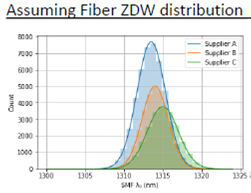Dear P802.3df TF Participants,
During last week’s meeting, Roberto presented actual
SMF Zero Dispersion Wavelength (ZDW) data collected by several manufacturers.

ITU-T G.652 SMF codes, which underlie all 802.3 optical standards, specify ZDW from 1300nm to 1324nm. Looking at the above graph, the astute observer may ask why are we worried about 1300nm. The puzzlement is well justified. 1300nm ZDW
fiber basically doesn’t exist. It is not to be found in any datacenter. Yet all 802.3 standards use the ITU-T ZDW limits. In addition to unnecessarily burdening design, this also potentially significantly increases testing cost. To properly test, fiber with
1300nm and 1324 ZDW must be used. This requires going to manufacturers and asking for custom fiber which includes custom doping and other non-standard steps, which is not conducive to low cost.
This is rarely, if ever, done for real manufacturing environments. Instead, standard SMF is used. The result is that almost all transceivers in the field are not actually verified for wavelengths near ZDW, for example CWDM4 L2. As a practical
matter, this works out just fine, because the transceivers never encounter the full ZDW range. In other words, IEEE 802.3 pretends to write a serious spec, and industry pretends to test to it.
We have repeatedly tried to make the 802.3 SMF ZDW spec. realistic, for example:
https://www.ieee802.org/3/cu/public/May19/cole_3cu_01a_0519.pdf
In each case, we have been instructed to go back to ITU-T and get the spec changed there. Because of a variety of reasons, some less than admirable, this has never been successful. A straightforward reason is that DWDM applications, which
are of primary interest in ITU-T, are in C-band where the exact value of ZDW doesn’t much matter. If you want to know the full story, please ask Peter Stassar who valiantly attempted numerous times to get this done.
As Baud rate goes up, this spec. becomes more important and we should base our optical specifications on realistic fiber parameters so that we don’t force manufacturers and users to wink and nod at each other that deployed optics meet specs.
We will be putting together a presentation to propose that we continue to use ITU-T G.652 SMF specs. but change ZDW for example to 1307nm to 1322nm, exact values TBDs. If you have interest in contributing please let me know. We are already
reaching out to fiber manufacturers.
Thank you
Chris
From: John D'Ambrosia <jdambrosia@xxxxxxxxx>
Sent: Thursday, October 13, 2022 3:31 PM
To: STDS-802-3-B400G@xxxxxxxxxxxxxxxxx
Subject: [802.3_B400G] Oct 2022 Session Unapproved Minutes Posted
All,
The unapproved minutes for the October 2022 session have been posted. Please see
https://www.ieee802.org/3/df/public/22_10/index.html [ieee802.org].
My thanks to Kent Lusted for his prompt turning around of minutes.
Please note that there were no additional changes made to the Oct 2022 Session Website.
Regards,
John D’Ambrosia
Chair, IEEE P802.3df Task Force
To unsubscribe from the STDS-802-3-B400G list, click the following link:
https://listserv.ieee.org/cgi-bin/wa?SUBED1=STDS-802-3-B400G&A=1
To unsubscribe from the STDS-802-3-B400G list, click the following link: https://listserv.ieee.org/cgi-bin/wa?SUBED1=STDS-802-3-B400G&A=1